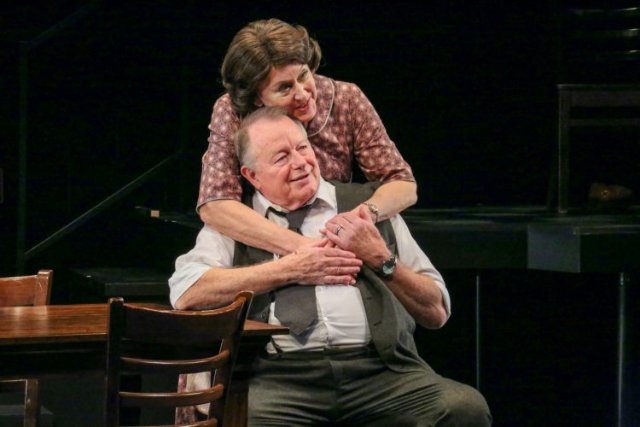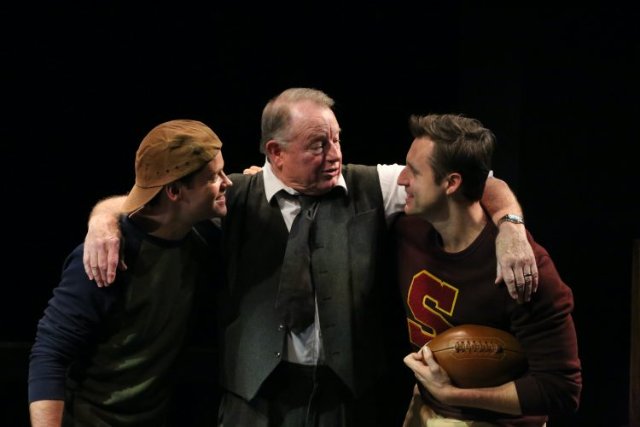Death of a Salesman
Palm Beach Dramaworks in South Florida
By: Aaron Krause - Apr 07, 2024
Attention must be paid Palm Beach Dramaworks’ emotionally powerful professional production of Arthur Miller’s classic play, Death of a Salesman. Truly, it is Carbonell Award worthy.
From Rob Donohoe’s heartbreakingly real portrayal of Willy Loman to J. Barry Lewis’s seamless, careful direction and costume designer Brian O’Keefe’s striking and appropriate period clothing, PBD’s production is a masterful mounting of a great play.
Recently, and unsurprisingly, Palm Beach Dramaworks (PBD) extended its run by three performances due to popular demand. Therefore, the production runs through April 20 (instead of its original closing date of April 14) in PBD’s intimate Don & Ann Brown Theatre. Its location is on Clematis Street in West Palm Beach. It might be wise to order tickets ASAP.
Believe it or not, 75 years have passed since Miller’s compelling, richly symbolic, creatively structured masterpiece first appeared on a stage. But judging from the audience’s reaction to the reviewed performance, Salesman remains as fresh, meaningful, and vital as when it debuted.
Chances are, you are familiar with this tragic tale. It tells of a travelling salesman who spent his life “riding on a smile and a shoeshine” only to realize that, at some point, the world stopped smiling back at him. Rather, they “eat the orange and throw the peel away,” as Willy accuses his boss, Howard, of doing. In other words, he uses up Willy’s value as a worker, and then tosses him aside as though he were trash when Howard no longer wants him.
True, Loman harbors a distorted view of the American Dream, believing that merely being “well liked” will make you rich and successful. Also, he is far from a perfect individual. But it’s practically impossible to be alive and not see somebody you know or love through the character. For instance, maybe Loman reminds you of an elderly relative who seems more confused than he was a couple years ago. Or perhaps the character reminds you of happy and tense moments you shared with your father. Perhaps, even, you see yourself in the character because, like him, you are wondering whether your life has amounted to anything.
Donohoe’s Willy is an insecure, vulnerable, tired everyman — the kind of person Miller elevated to the status of “Tragic Hero.”
Throughout theater history, tragic heroes were members of the nobility. But Miller came up with the idea to depict common, everyday people to whom we can relate more as tragic heroes. In a February 1949 New York Times essay titled “Tragedy and the Common Man, Miller wrote, in part, “I believe that the common man is as apt a subject for tragedy in its highest sense as kings were.”
Loman may be a small, insignificant everyman. In fact, it’s no accident that you pronounce Willy’s last name “Low-Man.” But one of live theater’s tallest orders is to believably portray Loman in all his complexity during “Death of a Salesman’s” run time of more than two hours. (PBD’s production includes a 15-minute intermission).
Over the years, great actors such as Lee J. Cobb (who originated the role), as well as Dustin Hoffman, Philip Seymour Hoffman, and Brian Dennehy have climbed into Willy’s skin.
No doubt, each of the aforementioned performers put their own stamp on the role. To his credit, Donohoe, a PBD veteran, also makes the part his own. He enters the stage stoop-shouldered and carrying cases. And you can hear Willy, deathly tired, breathing hard. Chances are, you can identify with Donohoe’s Willy right from the outset. That is especially true if you feel you are near burnout at your job.
Throughout the production, a grey-haired Donohoe scrunches his face into vivid and recognizable expressions of bewilderment, disappointment, exhaustion, anger, vulnerability, love, joy, and anguish. Also, the performer, who gestures naturally while speaking, segues seamlessly from one emotion to another. And Donohoe’s Loman speaks in a sharp voice to characters such as his boss, while he speaks in loving tones to his long-suffering and loving wife, Linda.
Speaking of her, PBD newcomer Helena Ruoti, with dark, shining eyes, imbues Linda with tenderness and compassion. Clearly, you can hear in her voice the love and concern that Linda has for her husband. Contrastingly, Ruoti sternly rebukes her grown sons, her voice dripping disgust. And Ruoti practically tears up believably at the end. That is when she kneels by Willy’s grave following his funeral. With the play’s title, it’s hardly a secret that Willy kills himself, figuring he is worth more to his family dead than alive.
Throughout the production, which includes Joshua Lubben’s mood-enhancing music, Donohoe and Ruoti are credible as a long, loving married couple. In addition to speaking adoringly to each other, their characters affectionately touch each other. For example, at one point, Linda gently massages Willy’s head.
At other points in the production, the characters use more force while touching each other. For instance, Willy roughly grabs his boss by the shirt after it becomes clear the company no longer wants him. Also, at least once, a character presses his hands to someone’s face. This conveys a sense of urgency.
Tension is palpable in the Loman home for much of the production. For example, at one point, Linda tries to shield her husband from an angry Biff. He looks as though he is about to physically attack, if not kill his father.
Michael Shenefelt delivers a powerful performance as Biff, especially toward the play’s end. Indeed, he sounds so realistically distraught that you feel for him and fear for him at the same time. Unquestionably, at this point, Shenefelt’s Biff is a yelling and sobbing mess of a young man, the kind of individual authorities would probably place under constant suicide watch. Of course, part of what upsets Biff so much is that he has discovered that his father has been trying to kill himself for some time.
Overall, Shenefelt presents a multifaceted performance. His Biff, brooding at times, is just as convincing when the young man is upbeat and energetic during the play’s brighter moments.
Speaking of upbeat, it’s an accurate adjective to describe Ty Fanning’s passionate and naturalistic portrayal of the aptly-named Happy, Biff’s younger brother.
Other characters enter and exit the action through Willy’s memory, with past and present existing side by side. The excellent supporting cast includes a wide-eyed and serious Harrison Bryan as Bernard, a William Hayes as devoted Loman neighbor, Charley, and Matthew W. Korinko as a curt Howard.
Miller was prepared to title his play The Inside of His Head. And just as Willy “sees” people who are not present, such as his wealthy, deceased brother, Uncle Ben (a seemingly satisfied and confident Tom Wahl) the director and his team ask us to use our imaginations when it comes to the scenic design. Indeed, Anne Mundell’s two-level set is minimalistic, comprised mostly of chairs and tables. But while the set design doesn’t place us in any specific location, it’s spacious enough for the actors to move about freely. Also, the set’s dark color befits this serious, tragic play.
Meanwhile, Kirk Bookman’s shadowy lighting befits a play that takes place, at least partially, in the past. Bookman’s lighting is brighter during scenes set in the present.
Adam J. Thompson’s projection design includes a neat effect. Specifically, we see a figure, whom we assume to be Willy, on screen. Suddenly, parts of him seem to escape his body. This might symbolize a broken, troubled man.
Lewis creates striking stage pictures as part of his detail-oriented direction, which also includes deft pacing.
The director has not altered the script, nor does he rely on gimmicks to bring this play to life for audiences in 2024. Rather, Lewis obviously trusts Miller’s script, which is strong for a number of reasons.
First, Death of a Salesman is simply a compelling story with characters who are easy to pull for and universal themes such as family, opportunity, reality, illusion and the dark side of capitalism.
Also, the play’s form and structure are creative. In particular, the play relates Willy’s life story over the course of 24 hours. Miller structured the piece so that it follows Willy’s thoughts, dreams, and memories.
In addition, the play wends its way from the stage to our hearts and our minds. There, it remains as an emotionally fulfilling piece that is also, in keeping with PBD’s motto, theater to think about.
IF YOU GO
WHAT: Palm Beach Dramaworks’ potent production of Arthur Miller’s classic play, Death of a Salesman.
WHEN: Through April 20. Evening performances are at 7:30 p.m. Wednesday through Saturday. Matinee performances start at 2 p.m. Wednesday, Thursday, Saturday and Sunday.
WHERE: PBD’s Don & Ann Brown Theatre, 201 Clematis St., West Palm Beach.
COST: Tickets for all performances are $89. Student tickets are available for $15 with a valid K-12 or university/college ID. Also, anyone under 40 pays $40 (no additional fees) with a photo ID. Tickets for educators are half price with proper ID (other restrictions apply). Group rates for 10 or more and subscription packages for four or five plays are also available. Call (561) 514-4042 or go to www.palmbeachdramaworks.org.


